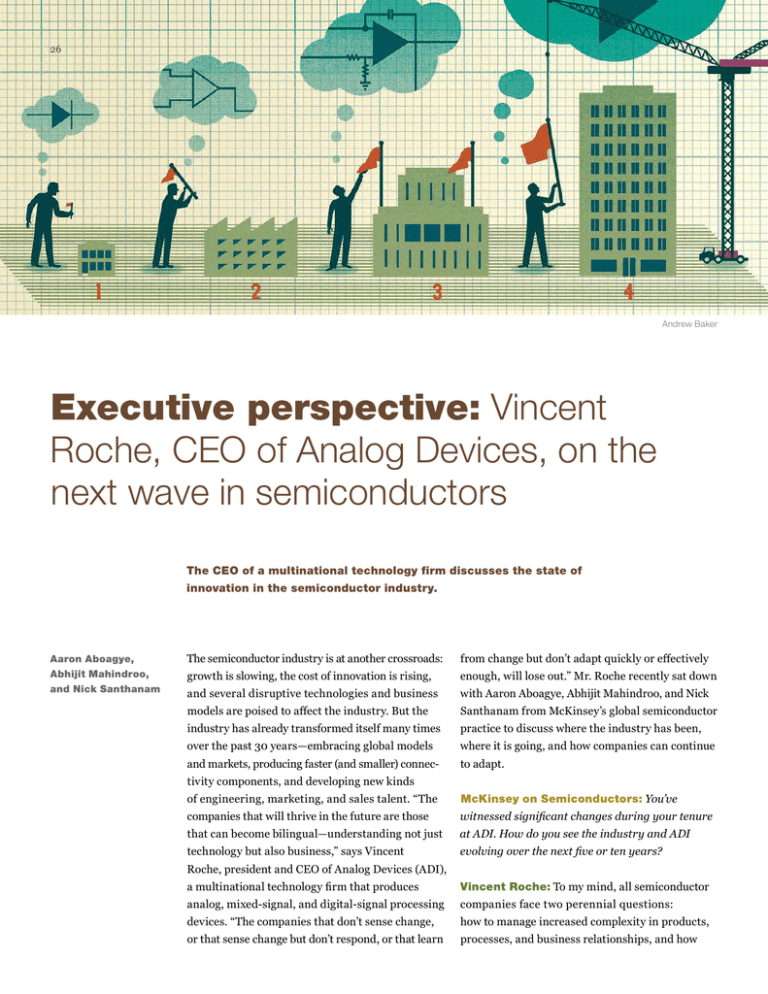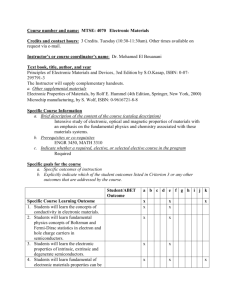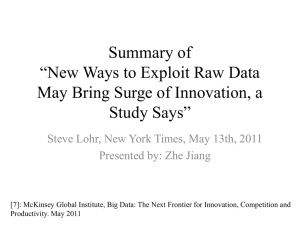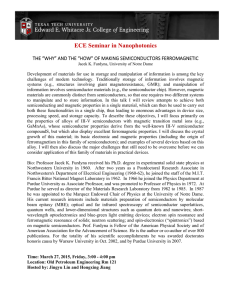
26
Andrew Baker
Executive perspective: Vincent
Roche, CEO of Analog Devices, on the
next wave in semiconductors
The CEO of a multinational technology firm discusses the state of
innovation in the semiconductor industry.
Aaron Aboagye,
Abhijit Mahindroo,
and Nick Santhanam
The semiconductor industry is at another crossroads:
from change but don’t adapt quickly or effectively
growth is slowing, the cost of innovation is rising,
enough, will lose out.” Mr. Roche recently sat down
and several disruptive technologies and business
with Aaron Aboagye, Abhijit Mahindroo, and Nick
models are poised to affect the industry. But the
Santhanam from McKinsey’s global semiconductor
industry has already transformed itself many times
practice to discuss where the industry has been,
over the past 30 years—embracing global models
where it is going, and how companies can continue
and markets, producing faster (and smaller) connec-
to adapt.
tivity components, and developing new kinds
of engineering, marketing, and sales talent. “The
McKinsey on Semiconductors: You’ve
companies that will thrive in the future are those
witnessed significant changes during your tenure
that can become bilingual—understanding not just
at ADI. How do you see the industry and ADI
technology but also business,” says Vincent
evolving over the next five or ten years?
Roche, president and CEO of Analog Devices (ADI),
a multinational technology firm that produces
Vincent Roche: To my mind, all semiconductor
analog, mixed-signal, and digital-signal processing
companies face two perennial questions:
devices. “The companies that don’t sense change,
how to manage increased complexity in products,
or that sense change but don’t respond, or that learn
processes, and business relationships, and how
27
to react to the pace of innovation. These will
ubiquity and power of communications technology
continue to be the main themes for many years to
and the extreme affordability of computing, there
come—not just for device companies but also
is a lot more they can do beyond building basic
for our customers.
industrial machines, cars, network gear, or other
hardware. They can connect their products to
ADI mirrors the broader semiconductor industry
the cloud, capture vast amounts of useful data,
in many ways. We are an almost 50-year-old
and potentially redesign their business models
company, and our first 25 years were all about “big
to create new sources of revenue around analytics.
iron”—the IBM mainframe era and industrial
These trends will be real game changers, and
measurement and control technologies. The second
ADI is embracing the opportunity to highlight our
25 years or so has ushered in the digital com-
expertise in connecting the physical and digital
munications and consumer eras, and we have capital-
domains. Our company and other semiconductor
ized on this to grow from $300 million to
players have a real growth opportunity here,
$3 billion in annual revenues.
because the devices we produce and sell can make
it easier for our customers to collect information,
We are in an auspicious period now—a third
perform sophisticated analysis, and do things
wave of evolution—where we are combining many
differently as a result.
products and technologies to do bigger things for
our customers while also managing the resulting
McKinsey on Semiconductors: Many
complexity. It’s analogous to the post-Cambrian
semiconductor players have become successful by
explosion. The industrial, healthcare, automotive,
leading device-level design in the industry.
and energy sectors are realizing big gains due to
Now we hear companies talking more and more
pervasive sensing, processing, and communication
about software and system-level offerings.
technologies. Meanwhile, we are seeing a
What are the implications of this trend?
tremendous reduction in the number of hardware
engineers, especially analog engineers, at our
Vincent Roche: Compared with other industries,
customers’ sites, and we are increasingly expected
semiconductor players, in aggregate, are investing
to fill that need by delivering more complete
more in R&D and getting less in return. We are
solutions. As a player at one node of the emerging
adding more complexity and sophistication to our
ecosystem, we need a deeper understanding
offerings—for instance, embedding software
of how to successfully interact and cooperate with
and algorithms and increasing the functionality of
all the other nodes to make a difference.
integrated circuits and systems-level offerings.
And as I mentioned, there has also been some
McKinsey on Semiconductors: Can you
expectation on the customers’ part that we will
comment about the Internet of Things and
provide certain hardware-engineering tasks and
the swirling attention around big data? What
support capabilities. However, we are still figuring
do these trends mean for customers, and by
out how to get paid for these basic innovations
extension, semiconductor players?
and the other extras that customers expect for free.
Vincent Roche: Personally, I think the term
Semiconductors are still the foundation of
Internet of Things is overused. That said, many of
innovation in the market for information and
our customers are realizing that, because of the
communications technologies. At the end of
28
McKinsey on Semiconductors Number 4, Autumn 2014
the day, no matter what our customers want to
McKinsey on Semiconductors:
do in the cloud or with sophisticated data analytics,
Semiconductor companies are facing ever-rising
they still need the silicon as a foundation—
R&D costs and high-risk returns. How can
and not just for incremental innovation but for real
executives successfully manage this challenge and
breakthroughs. The differentiating features in
continue to innovate?
most automobiles today, for instance, are a result
of the innovations that semiconductors enable.
Vincent Roche: At ADI, we believe that “superior
For a long time, a chip company was a chip
innovation makes for superior results.” We invest
company, but what does it look like now? We have
nearly 20 percent of our revenue in R&D, and as
to accept software development and systems
long as we’re growing, we believe that figure is
engineering as critical domains in our work flow,
appropriate. We need to bring more thoughtful
and we have to organize ourselves around
risk into the company, pick the places where
these needs. We have a road map for systems and
we play carefully, work closely with customers, and
software development at ADI, and it has
get better at getting rewarded for managing
become an important part of the innovation
the increasing design complexity. The best, most
conversation happening in the company.
innovative products we’ve launched over the
Vincent Roche
Education
Holds a BS in electrical
engineering from Limerick
University
Career highlights
Analog Devices
(1988–present)
CEO (May 2013–present)
Vice president of strategic
market segments group
(2009–13)
Fast facts
Began his career at ADI in
1988 as a senior marketing
engineer in Limerick,
Ireland, and has served in
various leadership roles
ever since
Executive perspective: Vincent Roche, CEO of Analog Devices, on the next wave in semiconductors
years have been the result of collaborative
and advice, and by collaborating in university
innovation with our customers—applying the best
research, we can help to improve the odds of
technologies imagined by our engineers toward
start-up success.
29
solving customers’ most critical challenges. This
approach has kept us relevant in the marketplace.
McKinsey on Semiconductors:
We are careful to strike a balance between being
Semiconductor players are increasingly looking
customer-centric and technology-forward.
toward mergers and acquisitions as a source of
growth and competitive advantage. But post-
As we do this, we do need to be thoughtful about
merger integrations are often troubled. In your
the amount of R&D and ideation we do internally
experience, what is the secret of a successful deal?
versus externally. I think it was IBM’s John Kelly
who once said, “The world is now our lab.” That is
Vincent Roche: The industry is in an acquisition
a striking and important statement. In addition
cycle, so as long as capital remains cheap, you’ll
to their own efforts, companies need to develop
continue to see companies in our industry
external relationships—with academic institutions,
pursuing new deals. There really is no magic bullet
industry bodies, and other companies—to
for succeeding in M&A, but you do need to be
create new technologies. This holds true for early-
clear about why you’re pursuing the deal. Are you
stage product development as well as latter-
simply responding to overactive investors? A smart
stage initiatives.
merger or acquisition is one where, in five years’
time, you are more relevant to your customers and
McKinsey on Semiconductors: Over the
bringing more capabilities and innovative
past decade, venture-capital funding and start-ups
products to bear. The deal has to make you more
focused on semiconductors seem to be declining.
competitive for the long term. You should imagine
Is this an issue? What can the industry do to deal
a conversation in which customers and share-
with this?
holders come back to you five years down the road
Vincent Roche: The industry needs to go beyond
was really beneficial, and we’re glad you did it.”
saying, “The combination of those two capabilities
an incremental approach. We need to tap into
new sources for ideas and breakthrough research,
Executives also need to be discriminating about
and start-ups can help in that regard. Venture-
their choice of targets. For instance, if innovation
capital firms have been smitten by faster returns
is built into the DNA of your company, you will
on software or Internet ventures, but there
need to pay special attention to culture: Is the target
are indications that venture-capital investments are
company’s culture compatible with your own?
beginning to swing back to semiconductors.
How quickly can new technologies and capabilities
be integrated? That was an important consider-
Hardware-development cycles are longer and
ation in our recent acquisition of Hittite Microwave.
costlier than ever. But if we are truly an industry
The executives there shared a very similar mind-
focused on the long term, thinking about the
set and culture with ADI—they were very focused
next couple of decades, we have a responsibility to
on innovation and developing new technologies
help manage this problem. By providing funding
and products for customers in markets that were of
30
McKinsey on Semiconductors Number 4, Autumn 2014
strong strategic interest to us. They were close
Analog, in particular, is a specialized craft. We
geographically, also in Massachusetts, which helps
train our people in foundational, core skills
a great deal. In an opportunity-rich and resource-
by exposing them to the greatest minds in our field.
constrained environment, such as we are in right
They go through multiple cycles of learning
now, it certainly helps to get more scale, but you
and stay with us a long time. I really think we are
need to make sure the conditions are right.
in great shape on the people front.
McKinsey on Semiconductors: With the rise
McKinsey on Semiconductors: What would
of online giants, semiconductor companies
you like your legacy to be at ADI?
are no longer the natural top choice for electrical
engineers and computer-science majors. What
Vincent Roche: We are a 50-year-old enterprise,
will it take to continue attracting top-tier talent to
and it is my goal to develop and position
the semiconductor industry?
ADI to thrive for the next 50 years. We will need
Vincent Roche: Just this morning, I met a group
and relative to the market. We will need to
to continually innovate, relative to our past
of bright, young engineers from Asia, Europe,
increase our fluency in both the technology and
and the United States, who are just beginning their
commercial domains.
careers at ADI. We talked about their aspirations,
what is happening in the world, in the industry, and
I am a student of evolutionary theory, and I think
with technology. If that group of people is any
great companies have the same attributes as
indication, I am very bullish on the future of our
great societies, cultures, and nations—they sense,
company and the industry. They are very
they learn, and they adapt. They don’t just
passionate about the work, and they want to
focus on competitors; they find mutually beneficial
innovate and make an impact on the world.
opportunities to cooperate.
We are attracting the brightest people from great
Additionally, I have been privileged to work with
colleges worldwide. Although the big Internet
two industry legends—Ray Stata and Jerry
companies have been grabbing the headlines and
Fishman—who built our business. I stand on
a lot of the engineering talent, I believe the
the shoulders of giants, and I hope to leave
pendulum is swinging back.
a legacy that they would also be proud of.
Aaron Aboagye (Aaron_Aboagye@McKinsey.com) is a principal in McKinsey’s New Jersey office,
Abhijit Mahindroo (Abhijit_Mahindroo@McKinsey.com) is an associate principal in the Southern California
office, and Nick Santhanam (Nick_Santhanam@McKinsey.com) is a director in the Silicon Valley office.
Copyright © 2014 McKinsey & Company. All rights reserved.



